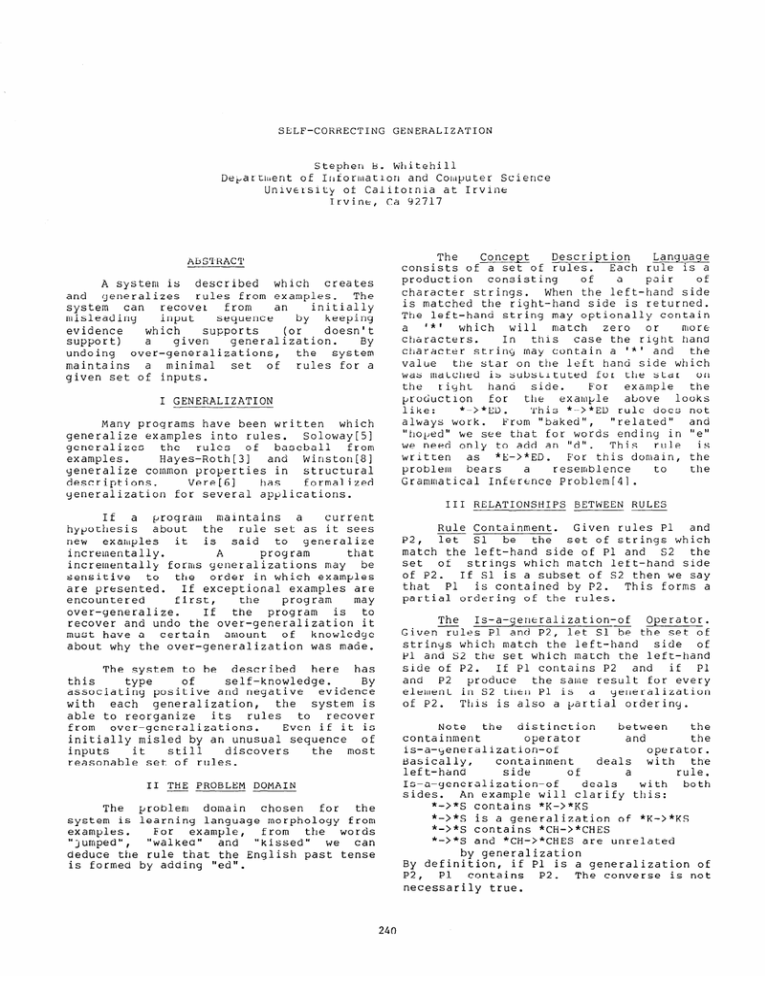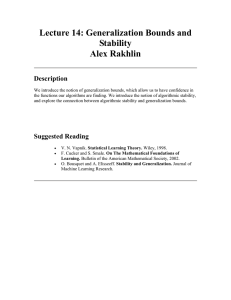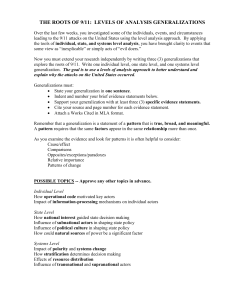SELF-CORRECTING GENERALIZATION Stephell B. Wilitehill Deyartment
advertisement

SELF-CORRECTING GENERALIZATION Stephell B. Wilitehill Deyartment of Irlformation and Computer Science University of California at Irvine Irvine, Ca 92717 ABSTRACT A system is described which creates and generalizes rules from examples. The system can from an initially recover misleading sequence input keeping bY evidence which supports doesn't (or support) a given generalization. By undoing over-generalizations, the system maintains a minimal set of rules for a given set of inputs. I GENERALIZATION Many programs have been written which generalize examples into rules. Soloway[5] generalizes the rules of baseball from examples. Hayes-Roth[3] and Winston[8] yeneralize common properties in structural descriptions. Vere[G] has formalized yeneralization for several applications. The Concept Description Language consists of a set of rules. Each rule is a production consisting of a pair of character strings. When the left-hand side is matched the right-hand side is returned. The left-hand string may optionally contain I*# which a will match zero or more cllaracters. this In case the right hand cklaracter string may contain a '*I and the the star on the left hand side which value was matched is suhstltuted for the star on the riyht side. hana For example the t11e protiuction example looks for above *->*Nl. like: 'l'his*->*ED rule does not always work. From "baked", "related" and "hoped" we see that for words ending in "e" we need only to add an 'Id". This rule is written as *E->*ED. For this domain, the problem bears resemblence to the Grammatical Inferznce Problem[4]. III RELATIONSHIPS If a program maintains a current hypothesis about the rule set as it sees new examples it is said to generalize incrementally. A program that incrementally forms generalizations may be sensitive to order in which examples the are presented. If exceptional examples are encountered first, the program may over-generalize. the program is to If recover and undo the over-generalization it must have a certain amount of knowledge about why the over-generalization was made. The system to be described here has this self-knowledge. of type BY associating positive and negative evidence with each generalization, system is the able to reorganize its rules to recover from over-generalizations. Even if it is initially misled by an unusual sequence of inputs it still discovers the most reasonable set of rules. II THE PROBLEM DOMAIN The problem domain chosen the for system is learning language rnorphology from examples. For example, from the words " j urnped" , "walked" and "kissed" we can deduce the rule that the English past tense is formed by adding "ed". BETWEEN RULES Rule Containment. Given rules Pl and let Sl be the set of strings which match the left-hand side of Pl and S2 the set of strings which match left-hand side of P2. If Sl is a subset of S2 then we say that Pl is contained by P2. This forms a partial ordering of the rules. p2 I The Is-a-generalization-of Operator. Given rules Pl and P2, let Sl be the set of strinys which match the left-hand side of Pl and S2 the set which match the left-hand side of P2. If Pl contains P2 and if Pl and P2 produce the same result for every element in S2 trlen Pl is d yeneralization of P2. This is also a partial ordering. Note the distinction between the containment operator and the is-a-qeneralization-of operator. Basically, containment deals with the left-hand side of a rule. Is-a-generalization-of deals with both sides. An example will clarify this: *->*S contains *K->*KS *->*S is a generalization of *K->*KS *->*S contains *CH->*CHES *->*S and *CH->*CHES are unrelated by generalization By definition, if Pl is a generalization of P2, Pl contains P2. The converse is not necessarily true. is a If Pl is a generalization generalization of P3 inserted in the main rule list before the witn which it will generalize. first rule If it will not generalize with any rule, it rule that is inserted before the first insertion contains it. The same rule algorithm is used to insert new rules or generalizations evidence. This means that place in an evidence list in the same take way that they do in the main rule list. of P2 and Pl then Pl is a a generalization of other common no generalization. Roughly, the maximal generalization is which common the one common features of the rules captures all given generalized. being E'or example, WALK->WALKED and TALK->TALKED, possible generalizations *->*ED, *K->*KED, are: *LK->*LKED and *ALK->*ALKED. The last one, the *ALK->*ALKED is the maximal one. In language we are using concept description all common generalizations are related on is-a-generalization-of the operator. Therefore in our domain the maximal common yeneralization is unique. IV ORGANIZATION V SYSTEM REORGANIZATION has Each blocked generalization generalization is knowledge which about blocking it. Whenever evidence for a blocked generalization Gl is entered into the rule structure, we check to see if is now more evidence for Gl than for there the blocking generalization G2. If so, G2 is moved to the position in the rule list immediately preceding Gl, G2 is marked as being blocked and Gl is no longer by Gl marked as being blocked. -OF RULES The and their evidence are rules in a tree structure. organized At the top level the rules are organized as a rule list. A rule list is a list of rules partially ordered on containment the rule may be contained by a operator. No rule which precedes it in the list. Associated with most rules is some evidence which is itself in the form of another rule The only rules without evidence are list. the example pairs whose evidence is fact. to terminal nodes in the These correspond If a rule Rl would contain evidence tree. follows it a rule R2 which then Rl is marked as blocked by R2. If Rl being R2 then evidence for Rl is negative blocks evidence for H2. There are several choices on how to negative compare positive and evidence. The one chosen is to count how much direct evidence there is for a Direct rule. evidence is that evidence found in the top list in the evidence level rule tree. Another metnod which was reJected for this application is to count the total number of pieces of evidence in the evidence tree. method The first was chosell because *Ch->*CHES and *X->*XES are exceptions to *-> *s (rather "A->*AS, than *B->*BS, being exceptions to *C->*CS, etc. *->*ES) is more direct evidence for there because *->*S (rules like *A->*AS) than for *->*ES. Even if half words in English used the *CH->*CHES this would still be an exception to *->*s. The positive evidence consists of those rules which were generalized into the current generalization. Negative evidence a generalization G is all the evidence for of generalizations that are blocked by G. .Thus when *->*ES blocks (*N->*NS + *K->*KS == > *->*S) that is negative evidence for *->*ES. evidence described here is The much like evidence used for explanation in or to maintain beliefs in [2]. In our [ll evidence system used for the is reorganization, but it could be used for these other purposes as well. This method produces the most reasonable set of rules. The system has been tested on pluralizing French adjectives. French has a much more complicated morphology than English, having not only exceptions to but also rules exceptions to exceptions. system was The found to produce the rules same for pluralizing French adjectives as those found in a French-English dictionary . A detailed example of this appears in [7]. Hule Application and Conflict Hesolution. When the interpreter rule produces a response, it is as if it finds a11 rules which match the given input and tnen uses the one which doesn't contain any of the others (informally, the one with the least general left-hand side). In reality the rules and rule interpreter are organized so that first that the rule matches is the desired one. VI UNDOING GENERALIZATIONS - AN EXAMPLE The system is written in MLISP and runs on UC1 LISP. The following example was annotated from a trace of the system in operation. The rules and evidence are printed as a tree. The evidence for a node is indented from the parent node in the printout. INPUT WORD? church WHAT IS RESPONSE? churches INPUT WORD? match WHAT IS RESPONSE? matches Inserting New Rules. If a rule has produced new the ----EOrrect result, the example pair is inserted into the evidence list for the rule. If the rule system has not produced the correct result the rule is 241 INPUT WORD? house IS RESPONSE HOUSES? y INPUT WORD? bunch IS RESPONSE BUNCHES? y The system now has a properly set and handle can both irregular cases. INPUT WORD? bus WHAT IS RESPONSE? buses RULES: *->*ES BUS->BUSCS *CH->*CHES MATCH->MATCHES ChUHCH->CHURCHES At this point we have over-generalized. We will this out later. find The only rule seen by tile rule interpreter is *-> *ES. BUS->BUSES arid *CH->*CdES are evidence for *->*ES. MATCH->MATCHES and CHURCH->CHURCHhS are evidence for the *CH->*CHES rule (which is itself evidence). INPUT WORD? book IS RESPONSE BOOKES? n WHAT IS RESPONSE? books INPUT WORD? back IS RESPONSE BACKES? n WHAT IS RESPONSE? backs RULES: B*K->B*KS BACK->BACKS BOOK->BOOKS *->*ES BUS->BUSES "CH->*CHES MATCH->MATCHES CHURCH->CHURCHES What should be regular cases are treated as exceptions. INPUT WORD? car IS RESPONSE CARES? n WHAT IS RESPONSE? cars RULES: (*->*s> CAR->CAKS B*K->B*KS BACK->BACKS BOOK->BOOKS *->*ES Bus->i3usLs *CH->*CfiES MATCH->MATCHES CHURCH->ChURCHES VII ordered regular rule and CONCLUSIONS giving a generalization program BY self-knowledge it can recover from initially misleading input sequences. This introspection can achieved by be associating positive and negative evidence with generalizations. Without knowledye about what led to a generalization, it is not possible to undo the generalization. The system described here discovers the reasonable set of morphological rules most for a yiven language construct (the set found in a dictionary) reyardless of the input sequence. Tne choice of language morpllology as the problem domain was arbitrary. domain with a concept Any descriptiorl whose maximal common language generalization is unique would serve just well. as Furtlier work is needed for concept description languages whose maximal common generalization is not necessarily unique. incremental generalization Any program irnprove its could ability to recover from misleading input by applying the techniques described. some REFERENCES [II point we want make the At this to generalization *->*s but this generalization is blocked by *->*ES. We generalization mark it as make the but that blocked. The indicated parentheses The only productions the rule is blocked. seen by the production system are: CAR->CARS, B*K->B*KS and *->*ES. The for blockage of *->*S is negative evidence will detect that the *->*lzs. The system rules are in the wrong order when there is evidence for *->*S (and hence against more *->*ES) than there is for *->*ES. At this just as much negative point there is evidence as down one positive (looking level in the evidence tree). INPUT WORD? bat IS HESPGNSE BATES? n WHAT Is RESPONSE? bats RULES: (*->*ES) BUS->BUSES MATCH->kATCHES *CH->*ChES CHURCH->CHUHCHES *-> *s CAR->CAhS B*K->B*KS BACK->BACKS BOOK->BOOKS BAT->BATS This addition negative evidence for *->*ES reordering of the rules. has caused a *->*s *->*ES is now blocked by (as it should be). Bechtel, R., Morris, P. and Kibler, D., "Incremental Deduction in a Real-time Environment", Canadian Society for the -Computational Studies of Intelligence (May 1980). "A Glimpse of J., Truth Main[21 Doyle, terlance", 6-IJCHI (1979), 232-237. c31 Hayes-Rotll, F. McDermott, and J ., “Knowledye Acquisition from Structurai Descriptions", Department of Computer Sciellce, Carnegie-Mellon Univ. (1976). [41 Hunt, c51 Soloway, E. and Riseman, E., "Levels of Pattern Description in Learning", 5-IJCAI (1977), 801-811. E. "Artificial Intelligence" 1975 S., "Induction of Relational [61 Vere, Productions in the Presence of Background Information", 5-IJCAI (19771, 349-355. [71 Whitehill, S., "Self-correcting alization". U.C. Irvine C.S. Report no. 149. (June 1980). GenerTech P -, "Le ar ning Structural [al Winst on, Descr iptio ns From EX ample s " , MIT-AI Techn ical Report 231 (1970 242


